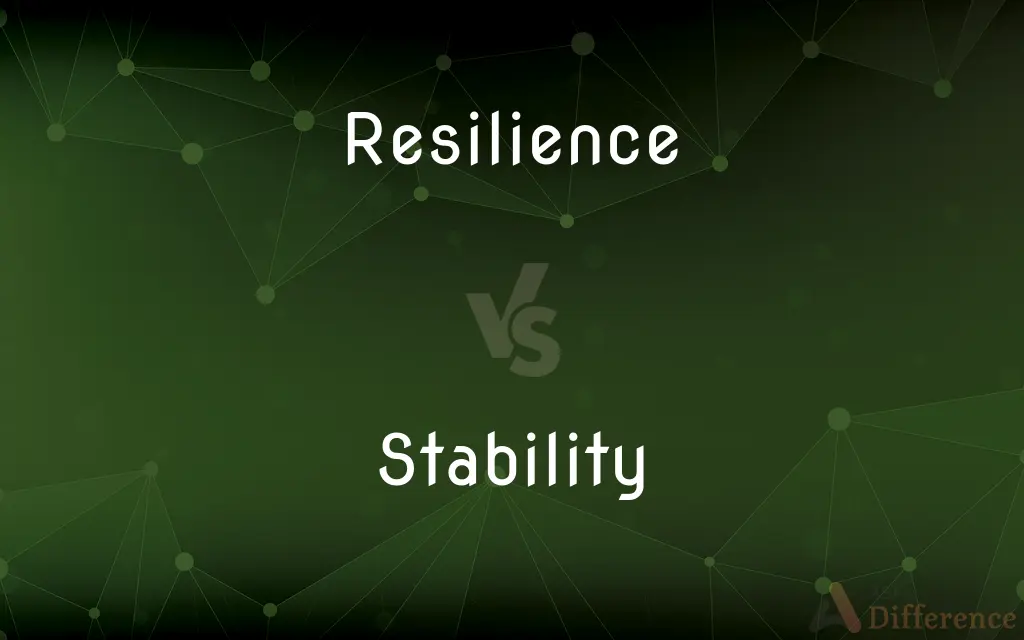Resilience vs. Stability — What's the Difference?
By Fiza Rafique & Urooj Arif — Updated on April 5, 2024
Resilience is the capacity to recover quickly from difficulties, while stability refers to the ability to remain unchanged or steady in the face of challenges.

Difference Between Resilience and Stability
Table of Contents
ADVERTISEMENT
Key Differences
Resilience emphasizes adaptability and recovery in the face of adversity. It involves bouncing back from setbacks, learning from failure, and continuing to move forward. In contrast, stability focuses on maintaining a steady state, resisting disruptions, and remaining constant despite external pressures.
While resilience suggests a dynamic process of adjustment and improvement after disturbances, stability implies a static condition where systems or individuals are unaffected by external changes. Resilience is about coping with change and returning to a previous state or reaching a new, functional state, whereas stability is about preventing change from affecting the system or individual in the first place.
In psychological terms, resilience is often associated with personal growth and emotional strength that develops through overcoming obstacles. Stability, on the other hand, is linked to consistency in one's thoughts, feelings, and behaviors over time, offering a sense of predictability and security.
Organizations that focus on resilience invest in flexibility and adaptability, preparing to respond to changes and challenges effectively. In contrast, organizations prioritizing stability might invest in structures and processes that minimize risk and variance, aiming for predictability in outcomes.
Environmental resilience refers to an ecosystem's ability to absorb disturbances and reorganize while undergoing change to still retain essentially the same function, structure, and feedbacks. Environmental stability, however, describes an ecosystem's ability to resist change and remain in equilibrium.
ADVERTISEMENT
Comparison Chart
Definition
Ability to recover quickly from difficulties.
Ability to remain unchanged or steady despite challenges.
Focus
Adaptability and recovery.
Prevention of change and maintenance of status quo.
Psychological Aspect
Associated with growth and emotional strength.
Linked to consistency and predictability.
Organizational Context
Emphasizes flexibility and response to change.
Focuses on minimizing risk and maintaining predictability.
Environmental Context
Ability to absorb disturbances and maintain function.
Resistance to change and maintenance of equilibrium.
Compare with Definitions
Resilience
Capacity to recover from or adjust easily to misfortune or change.
After the earthquake, the community's resilience was evident in their swift rebuilding efforts.
Stability
The state or quality of being steady and not prone to fall.
The table's stability was ensured by adjusting its legs to be perfectly level.
Resilience
Physical property of a material to return to its original shape after deformation.
The resilience of the foam ensures it supports and adapts to varying weights.
Stability
The quality of being free from change or variation.
The stability of his routine provided him comfort during uncertain times.
Resilience
Emotional strength in facing difficulty or trauma.
Her resilience after the loss was inspiring, focusing on positive memories and future goals.
Stability
Emotional or psychological steadiness.
Her emotional stability was a cornerstone of her leadership during the crisis.
Resilience
Ability of a system or organization to respond to or recover from a crisis.
The company's resilience was tested by the market downturn, but it emerged stronger.
Stability
The capacity of an ecosystem to remain in equilibrium.
The forest's stability is threatened by invasive species that disrupt its balance.
Resilience
Ecological capacity to absorb disturbances and reorganize while undergoing change.
The wetland's resilience to flooding helps protect the surrounding communities.
Stability
Resistance to change, especially sudden change or deterioration.
The financial stability of the company allowed it to invest in new projects.
Resilience
The capacity to recover quickly from difficulties; toughness
The often remarkable resilience of so many British institutions
Stability
Resistance to change, deterioration, or displacement.
Resilience
The ability of a substance or object to spring back into shape; elasticity
Nylon is excellent in wearability, abrasion resistance and resilience
Stability
Constancy of character or purpose; steadfastness.
Resilience
The ability to recover quickly from illness, change, or misfortune; buoyancy.
Stability
Reliability; dependability.
Resilience
The property of a material that enables it to resume its original shape or position after being bent, stretched, or compressed; elasticity.
Stability
The ability of an object, such as a ship or aircraft, to maintain equilibrium or resume its original, upright position after displacement, as by the sea or strong winds.
Resilience
The mental ability to recover quickly from depression, illness or misfortune.
Stability
Roman Catholic Church A vow committing a Benedictine monk to one monastery for life.
Resilience
(physics) The physical property of material that can resume its shape after being stretched or deformed; elasticity.
Stability
The condition of being stable or in equilibrium, and thus resistant to change.
This platform offers good stability
Resilience
The positive capacity of an organizational system or company to adapt and return to equilibrium after a crisis, failure or any kind of disruption, including: an outage, natural disasters, man-made disasters, terrorism, or similar (particularly IT systems, archives).
Stability
The tendency to recover from perturbations.
Emotional stability
Resilience
The capacity to resist destruction or defeat, especially when under extreme pressure.
Stability
The state or quality of being stable, or firm; steadiness; stableness; firmness; strength to stand without being moved or overthrown; as, the stability of a structure; the stability of a throne or a constitution.
Resilience
The act of springing back, rebounding, or resiling; as, the resilience of a ball or of sound.
Stability
Steadiness or firmness of character; firmness of resolution or purpose; the quality opposite to fickleness, irresolution, or inconstancy; constancy; steadfastness; as, a man of little stability, or of unusual stability.
Resilience
The power or inherent property of returning to the form from which a substance is bent, stretched, compressed, or twisted; elasticity[1]; springiness; - of objects and substances.
Stability
Fixedness; - as opposed to fluidity.
Since fluidness and stability are contrary qualities.
Resilience
The power or ability to recover quickly from a setback, depression, illness, overwork or other adversity; buoyancy; elasticity[2]; - of people.
Stability
The quality or attribute of being firm and steadfast
Resilience
The mechanical work required to strain an elastic body, as a deflected beam, stretched spring, etc., to the elastic limit; also, the work performed by the body in recovering from such strain.
Stability
A stable order
Resilience
The physical property of a material that can return to its original shape or position after deformation that does not exceed its elastic limit
Stability
The quality of being free from change or variation
Resilience
An occurrence of rebounding or springing back
Common Curiosities
How can an organization achieve both resilience and stability?
By creating robust systems that are adaptable to change while maintaining core functions and values stable.
Can too much stability lead to a lack of resilience?
Yes, excessive stability can result in rigidity, making it harder to adapt to new challenges.
Can resilience and stability coexist?
Yes, they can complement each other. A system or individual can be stable yet also capable of adapting and recovering from changes.
Is resilience more important than stability?
The importance varies depending on context; resilience is crucial in rapidly changing environments, while stability is essential in providing a foundation for consistent growth.
How does resilience affect personal growth?
Resilience is often linked to personal growth, as overcoming challenges can lead to increased strength, wisdom, and emotional intelligence.
What role does stability play in mental health?
Stability, particularly in routines and relationships, can provide a sense of security and predictability that supports mental health.
Can an individual's resilience be improved?
Yes, resilience can be developed through experiences, support networks, and intentional practice of coping strategies.
What is an example of stability in a financial context?
A country maintaining a consistent economic growth rate and low inflation over many years showcases financial stability.
Can psychological stability exist without resilience?
Psychological stability might be temporarily achieved without resilience, but true, lasting stability often requires resilience to navigate life's inevitable challenges.
How do stability and resilience differ in their response to change?
Stability aims to minimize the impact of change, while resilience focuses on recovering from the impact of change.
Is stability always a sign of health in an ecosystem?
While stability can indicate health, dynamic equilibrium, where there is some level of change and adaptation, is often a more accurate indicator of a healthy ecosystem.
What is an example of resilience in nature?
A forest recovering from a wildfire, adapting and eventually thriving again, demonstrates ecological resilience.
What is a practical step to increase individual resilience?
Developing a positive mindset, maintaining strong social connections, and practicing stress management techniques can enhance personal resilience.
How do resilient leaders benefit organizations?
They inspire adaptability, foster a culture of learning from failure, and guide organizations through crises.
How can a society enhance its resilience?
By fostering strong community ties, building adaptable infrastructure, and promoting policies that support recovery and adaptation to challenges.
Share Your Discovery

Previous Comparison
Documentary vs. Biopic
Next Comparison
Entertaining vs. InterestingAuthor Spotlight
Written by
Fiza RafiqueFiza Rafique is a skilled content writer at AskDifference.com, where she meticulously refines and enhances written pieces. Drawing from her vast editorial expertise, Fiza ensures clarity, accuracy, and precision in every article. Passionate about language, she continually seeks to elevate the quality of content for readers worldwide.
Co-written by
Urooj ArifUrooj is a skilled content writer at Ask Difference, known for her exceptional ability to simplify complex topics into engaging and informative content. With a passion for research and a flair for clear, concise writing, she consistently delivers articles that resonate with our diverse audience.
















































